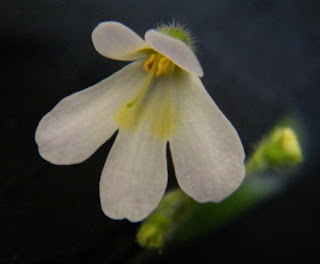
Petrocosmea barbata flower
I'll start my posts about Petrocosmeas with the species that often is the first to begin blooming for me each autumn. This year, all of my Pets are blooming earlier than usual, and P. barbata once again kicked the season off in grand style! Petrocosmea barbata is one of the newer Petrocosmea species brought into cultivation only within the last ten years or so. While it's flowers are not the showiest or largest of the Pet species, it does hold a certain charm and "daintiness" that the other species lack. It has a number of characteristics that set it apart.
P. barbata forms a smaller, and less symmetrical rosette than most Pets. The leaves are unique in the genus in that they are reniform, or fan shaped...much like a ginko leaf. The center of this species can be a tight cluster of cupped and curled young leaves, covered in silvery hairs, giving some who grow African violets the impression that the plant may have a cyclamen mite infestation. Often, the outer leaves will yellow and wither, leaving only this tight little cluster of green center leaves throughout the late winter and early spring season. Then, in mid to late spring, they open up and start to enlarge, and the plant will quickly form a larger, more open rosette. It tends to bloom in late summer or early autumn for me here in Pennsylvania. The flowers often open white, and may darken to a pale lavender purple color with a pale yellow spot at the base of the throat. The photo above is a good representation of the typical P. barbata flower. Flowers are short lived, only lasting five or six days before dropping.
Two years ago, one of several little plantlets that had formed from leaf cuttings of my only plant, began to grow larger and had larger leaves, of a slightly different shape from the mother plant. I set this little guy aside as a "keeper". As it bloomed, there was hardly a normal flower on the plant. All of the flowers either had extra petals or were peloric (rounded, radially symmetrical). The flowers were slightly smaller than normal, but the plant flowered more heavily and the flowers also had a larger and deeper yellow blotch in the throat than the mother plant. I've kept this clone now for three bloom cycles and have decided it is indeed superior in several respects to it's mother. I've given it the cultivar name 'Keystone'. Below is a photo of a single flower, and of the whole plant in flower this season. The plant forms a rosette that is noticeably fuller and larger than it's mother and also has leaves of a different shape, often irregularly shaped. I find it easier to grow than it's mother also. I hope that the new cultivar will be a popular addition to the collections of Pet lovers! I am propagating it now for distribution.
My hope is to also use P. barbata 'Keystone' in my hybridizing program with the goal of getting more yellow in flowers, perhaps even solid yellow flowers, and flowers with extra petals or doubles. It's tendency to be a heavy bloomer will also support my hybridizing goal of Petrocosmeas that bloom more heavily and with a bloom season that starts earlier and lasts longer. This plants tendency to bloom in August, when many other Pets are not in flower, may help extend the bloom season for the genus.
Discovering this gem among the plantlets that propagated from the leaves of the same plant was a good example of why it is important to watch young plants closely for those that "behave" differently. Keep those, as they may grow up to represent a new mutation or sport.
I'm delighted with my new addition to my collection!
Good growing!
Tim


